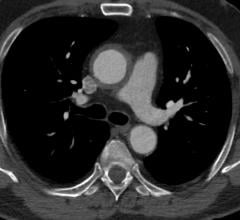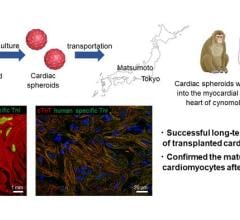December 29, 2010 - Research on reducing risks, improving medical treatment and improving lifestyle behaviors to fight the battle against heart disease and stroke are among the key scientific findings that make up this year's top cardiovascular and stroke research recognized by the American Heart Association/American Stroke Association.
The association has been compiling an annual list of the top 10 major advances in heart disease and stroke research since 1996. This year, for the first time, two separate lists have been compiled that highlight the top 10 research advances in each respective area.
"We have come far in the past decade, reducing heart disease deaths by more than 27 percent and stroke deaths by more than 44 percent," said Ralph Sacco, M.D., president of the AHA and chairman at the department of neurology for the Miller School of Medicine at University of Miami. "But we know there is still much to be done in improving the lives of heart disease and stroke patients – and more importantly, in preventing these devastating diseases in the first place. Scientific research will help us lead the way. "
Highlights in 2010 noted by the association include (in no ranking order):
Top 10 Advances in Cardiovascular Research in 2010
1. Tailoring treatment for people with diabetes to reduce their risk of cardiovascular disease
More than 17 million Americans are diagnosed with diabetes, and heart disease death rates are two to four times higher for them compared to people without diabetes. New research from the ACCORD Study Group offers insight into specific treatments that can reduce their risk of cardiovascular disease (CVD). The first study found that aggressive blood pressure control does not reduce CVD risk in people with type 2 diabetes at high risk for CVD. In a second study, a combination therapy with a statin plus a fibrate was no better at reducing risk than a statin alone in patients with type 2 diabetes at high risk for CVD. However, the combination lipid therapy may be successful in reducing CVD risk in those type 2 diabetes patients who had low HDL cholesterol and low triglycerides. These results will be helpful for targeting specific treatments that best reduce CVD risk in people with diabetes.
The ACCORD Study Group – New England Journal of Medicine, March 14, 2010, 362:1575-85. N Engl J Med 2010; 362:1563-74. www.nejm.org; Funding: National Heart, Lung, and Blood Institute and other National Institutes of Health divisions.
2. New advances for patients who aren't candidates for conventional valve surgery
Many patients with severe aortic blockage have other medical conditions that make it risky for them to have conventional surgery to replace the blocked aortic valve. Transcatheter aortic valve implantation (TAVI) is an emerging alternative therapy to open-heart surgery in these high-risk patients. Two new studies support the evidence that TAVI can improve symptoms and outcomes – including quality of life – even over the course of several years. While there are some risks associated with TAVI, including strokes and other major cardiovascular events, the catheter-based procedure offers significant progress in this area.
PARTNER Trial Investigators – New England Journal of Medicine, Sept. 22, 2010, 363(17):1597-607. www.nejm.org; Funding: Edwards Lifesciences.
Ye, et al – Journal of Thoracic and Cardiovascular Surgery, May 1, 2010, 139:1107-1113. http://jtcs.ctsnetjournals.org; Funding: Edward Lifesciences.
3. Improving the way we reverse sudden cardiac arrest
More than 300,000 people suffer out-of-hospital sudden cardiac arrest each year. Many die because the people around them didn't know how to or were uncomfortable performing cardiopulmonary respiration (CPR). Significant studies now report that chest compression only, or "Hands Only CPR" for adults by bystander lay rescuers improves survival outcome. Public awareness campaigns resulted in increased use of hands only CPR, as well as improved survival rates. While the new procedure appears successful in adults, it is important to note that using conventional chest compressions with rescue breathing is still important for children stricken with sudden cardiac arrest. In October, the American Heart Association issued updated Guidelines for Cardiopulmonary Resuscitation and Emergency Cardiovascular Care Science, reflecting new advances in this field.
Bobrow, et al – Journal of the American Medical Association, Oct. 6, 2010, 304(13):1447-54; www.jama.com; Funding: Support from Medtronics Foundation
Rea, et al – New England Journal of Medicine, July 29, 2010, 363(5):423-33. www.nejm.org; Funding: Laerdal Foundation for Acute Medicine, Medic One Foundation.
Field, et al – Circulation, Oct. 18, 2010; 122[suppl 3]:S640 –S656.
4. More options for reducing stroke risk in atrial fibrillation
For the first time in more than 20 years there are viable alternatives to the primary prevention of stroke for patients with atrial fibrillation (AF). AF is a major risk factor for stroke and affects more than 2 million people over the age of 65. Warfarin (Coumadin) has long been the standard anticlotting drug used to reduce the risk of stroke for these patients. But it carries its own complications from bleeding, and managing the dose requires regular blood tests, making it difficult to manage for both patients and doctors. Now, several new drugs have been found to work as well as warfarin – and are simpler for patients to take – offering an important advance in this field. In October 2010, following further positive findings from the RE-LY trial, the U.S. Food and Drug Administration approved dabigatran for stroke prevention in AF patients. The ROCKET-AF trial presented at the American Heart Association's Scientific Sessions 2010. Rivaroxiban, apixiban, edoxaban and other oral anticoagulants are being or have been studied in AF and may show future promise.
RE-LY - Lancet, Sept. 18, 2010, 18;376(9745):975-83; www.thelancet.com. Funding: Boehringer Ingelheim.
ROCKET-AF – American Heart Association Scientific Sessions 2010, Abstract 21839. Funding: Johnson & Johnson, Bayer HealthCare.
AVERROES – European Society of Cardiology Congress 2010. Funding: Bristol-Myers Squibb Company, Pfizer.
5. Adjusting pacing therapies can improve outcomes for heart failure patients
Many heart failure patients experience abnormal heart rhythms, known as arrhythmia. There are a number of devices available to treat arrhythmia, including implantable cardioverter defibrillators (ICDs) which can shock the heart beat back into a normal rhythm. New studies show that adding additional resynchronization pacing to ICD therapy can lead to improved outcomes in an expanded group of heart failure patients. In addition, new types of ICDs (defibrillators without leads, for example) can offer options that reduce some of the risks associated with traditional devices.
MADIT-CRT Trial Investigators – New England Journal of Medicine, Sept. 1, 2009, 361(14) 1329-1338. www.nejm.org; Funding: Boston Scientific.
RAFT Investigators – American Heart Association Scientific Sessions 2010, Abstract 21768; New England Journal of Medicine, Nov. 14, 2010, 10.1056/nejmoa1009540. www.nejm.org. Funding: Canadian Institutes of Health Research; Medtronic of Canada.
Bardy, et al – New England Journal of Medicine, May 12, 2010, 363:36-44. www.nejm.org. Funding: Cameron Health.
6. Hopeful new procedure for infants with congenital heart disease
The Pediatric Heart Network's randomized trial of Norwood shunt types in infants with single-ventricle lesions showed that the type of shunt used makes a difference in outcomes. Better transplantation-free survival at 12 months is a possibility with this new understanding of the better shunt choice for these patients. This was the first large-scale randomized trial in congenital heart surgery, offering an approach that should provide answers to other questions in the future.
Pediatric Heart Network Investigators – New England Journal of Medicine, May 27, 2010, 362:1980-1992. www.nejm.org. Funding: National Heart, Lung, and Blood Institute.
7. Finding the right anticlotting (antiplatelet) therapy
Selecting the right type of anticlotting drug and the right dosage can be tricky, and risky. New research from the PLATO investigators has found that ticagrelor may improve outcomes and reduce adverse events better than the current standard, clopidogrel. The CURRENT-OASIS 7 Trial is exploring the optimal dosing of clopidogrel and aspirin in patient undergoing invasive surgery. These studies will help providers better understand the situations where new choices and dosages may improve results for the patient.
PLATO Investigators – Lancet, Jan. 14, 2010, 375:283-93. www.thelancet.com. Funding: AstraZeneca.
CURRENT-OASIS 7 Investigators – New England Journal of Medicine, Sept. 2, 2010, 363:930-42. www.nejm.org. Lancet, Sept. 1, 2010, 376:1233-43. www.thelancet.com. Funding: Sanofi-Aventis; Bristol-Myers Squibb
8. Basic science findings offer insight into future progress
Several studies this year brought the future of medicine closer to the present with new insight into emerging technologies. Findings from stem cell therapy have shown improved quality of life and survival in several early studies of patients with chronic heart failure and support the development of future cell-based therapeutics. A large animal study defined the basic mechanisms for heart muscle regeneration initiated by specific types of stem cells. The results demonstrated that these stem cells repair scarred myocardium through promotion of the generation of new heart muscle and blood vessel). A second study supported the notion that the heart has the capacity to regenerate large numbers of heart muscle cells several times during its lifetime. Being able to directly reprogram stem cells into working heart muscle is a big step toward use in therapeutic settings. The STaR-Heart Study showed that injecting the patient's own bone marrow stem cells into the heart improved hemodynamics and long-term survival in the treatment of chronic heart failure
Hatzistergos, et al – Circulation Research, July 29, 2010, 107(7):913-22. http://circres.ahajournals.org. Funding: National Heart, Lung and Blood Institute.
Kajstura et al – Circulation Research, June 3, 2010, 107(2):305-15. http://circres.ahajournals.org. Funding: National Institutes of Health.
The STAR-heart study – European Journal of Heart Failure, doi:10.1093/eurjhf/hfq095. Funding: Cardiogenesis Corporation.
9. Using science to support healthy lifestyle behaviors
New science examining lifestyle behaviors in adults and children, with particular emphasis on physical activity and consumption pattern, show that such conditions as obesity and hypertension are positively influenced by a change in diet with decreasing sodium levels. Results from the school setting suggest that the earlier one starts to adopt healthy behaviors the better the effect on health outcomes. Furthermore, physical activity is an important lifestyle factor in improving cardio-metabolic factors, especially in those trying to reduce weight. Although most people don't associate poor diet quality and physical inactivity with heart disease, the American Heart Association has created a national goal to improve seven health factors and lifestyle behaviors in support of raising awareness and helping all Americans move closer to optimal heart health over the next decade.
Bibbins-Domingo et al – New England Journal of Medicine, Jan. 20, 2010, 362:590-9. www.nejm.org. Funding: American Heart Association Western States Affiliate; University of California, San Francisco Clinical and Translational Sciences Institute
The HEALTHY Study Group – New England Journal of Medicine, July 20, 2010, 10.1056. www.nejm.org. Funding: National Institutes of Health; American Diabetes Association
Franks et al – New England Journal of Medicine, Feb. 11, 2010, 362(6):485-93. www.nejm.org. Funding: National Institute of Diabetes and Digestive and Kidney Diseases.
Goodpaster, et al – Journal of the American Medical Association, Oct. 9, 2010. www.jama.com. JAMA 304(16):1795-1802; Funding: Commonwealth of Pennsylvania Department of Health.
10. Get With The Guidelines participation eliminates disparity gaps in care
Racial and ethnic disparities have been found in the quality of care delivered to patients with cardiovascular disease and achieving equity and addressing disparities has implications for quality, cost, risk management, and community benefit. Eliminating these disparities is a top priority for the American Heart Association. These findings are the first to show that participating in a quality improvement program, such as Get With The Guidelines – Coronary Artery Disease, can eliminate racial and ethnic disparities of care while increasing the overall use of evidence-based care for heart attack patients.
Cohen et al – Circulation, June 1, 2010, 121(21):2294-301; http://circ.ahajournals.org. Funding: GWTG-CAD is supported by the American Heart Association in part through an unrestricted education grant from Merck/Schering-Plough Partnership.
Top 10 Advances in Stroke Research in 2010
1. "Time is brain": Clot-dissolving treatment for acute ischemic stroke found beneficial in the first 4.5 hours after onset, potentially harmful later
A combined patient analysis of eight trials of intravenous tissue plasminogen activator (tPA) for acute ischemic stroke reinforced prior findings of a strong time-to-treatment effect, with greatest benefit in the first few hours after onset, and, for the first time, demonstrated increased mortality from late treatment beyond 4.5 – 6 hours after onset.
Pooled analysis of the ECASS, ATLANTIS, NINDS and EPITHET trials – Lancet, May 15, 2010, 375(9727):1695-703. www.thelancet.com. Funding: There was no funding source for this study.
2. New mechanism of emboli clearance from the brain vasculature discovered
This study identified an entirely new way by which brain blood vessels are kept open by the body in the face of clots – extravasation. Clots that are not able to be dissolved are sometimes pushed out through blood vessel walls into the surrounding tissue, restoring nourishing flow in blood vessels.
Lam, et al; Nature, May 27, 2010, 465:478-482. www.nature.com. Funding: No funding sources were listed.
3. Carotid endarterectomy and carotid artery stenting directly compared
The large CREST trial compared head-to-head the two major methods to reopen narrowed carotid arteries carrying blood flow to the brain: carotid endarterectomy (open surgical repair) and carotid stenting (endovascular placement of a stent). Overall, both techniques had similar rates of success and complication, but among younger patients, under 70 years of age, stenting appeared advantageous while among older patients endarterectomy appeared advantageous. Those findings were also supported in a preplanned meta-analysis of individual patient data from three randomized controlled trials.
CREST – New England Journal, July 1, 2010, 363(1):11-23. www.nejm.org.. Funding: National Institute of Neurological Disorders and Stroke (NINDS).
Carotid Stenting Trialists' Collaboration – Lancet, Sept. 10, 2010, 376:1062-73. www.thelancet.com. Funding: Medical Research Council, the Stroke Association, Sanofi-Synthelabo, European Union.
4. Million person milestone, emerging research shows quality initiatives improve outcomes
In an analysis of the first 1 million stroke patients enrolled in the national Get With the Guidelines – Stroke quality improvement program at nearly 1,400 hospitals across the country, quality of care on 10 performance measures improved substantially from 2003 to 2009. More than 80 percent of patients were receiving defect-free care by 2009, up from less than half in 2003. The Get With The Guidelines database is an invaluable resource in furthering development of tools and outcomes results that are making marked improvement in stroke patient care.
Fonarow, et al – Circulation: Cardiovascular Quality and Outcomes, Feb. 22, 2010, 3;291-302. http://circoutcomes.ahajournals.org.
Smith, et al - Circulation, Sept. 27, 2010, 2010;122:1496-1504. http://circ.ahajournals.org.
Saver, et al – Stroke, June 3, 2010,41: 1431-1439. http://circ.ahajournals.org.
Reeves, et al – Stroke, May 20, 2010, 41(7):1573-8. http://stroke.ahajournals.org.
Funding: Get With The Guidelines–Stroke (GWTG-Stroke) is provided by the American Heart Association/American Stroke Association. The program is currently supported in part by a charitable contribution from Bristol-Myers Squib/Sanofi Pharmaceutical Partnership and the American Heart Association Pharmaceutical Roundtable. GWTG-Stroke has been funded in the past through support from Boeringher-Ingelheim and Merck.
5. International study identifies the ten major risk factors for stroke
In the worldwide INTERSTROKE study, 10 simple risk factors were found to be associated with 90 percent of the risk of stroke. Targeted interventions that reduce blood pressure and smoking, and promote physical activity and a healthy diet, could substantially reduce the worldwide burden of stroke.
INTERSTROKE Investigators – Lancet, June 18, 2010, 376,112-123. www.thelancet.org. Funding: Canadian Institutes of Health Research, Heart and Stroke Foundation of Canada, Canadian Stroke Network, Pfizer Cardiovascular Award, Merck, AstraZeneca, Boehringer Ingelheim.
6. Ultrasound detection of silent emboli identifies patients at high risk of stroke
This international, multicenter, prospective study confirms that detection of silent, microclots traveling to the brain on transcranial Doppler ultrasound identifies a subgroup of patients with asymptomatic narrowing of the carotid artery who are at high risk for stroke and might benefit from surgery or stenting.
ACES – Lancet Neurology, July 2010, 9(7):663-71. www.thelancet.com. Funding: British Heart Foundation.
7. Robot-assisted therapy beneficial for long-term arm impairment after stroke
This randomized trial suggested that robot-assisted therapy can improve the rehabilitation of arm function after stroke compared with ordinary care, though no more than intensive therapist care.
Lo, et al – New England Journal of Medicine, May 16, 2010, 362(19):1772-83. www.nejm.org. Funding: Veterans Affairs Cooperative Studies Program and Rehabilitation Research and Development Service.
8. Genetic findings important in understanding, treating aneurysms
Two new studies looked at the genetics and treatment of aneurysms, balloon-like dilations of arterial walls that can be fatal if they rupture or tear. Saccular intracranial aneurysms are located in the intracranial arterial wall; their hemorrhage commonly results in severe neurologic impairment and death. This multicenter genome-wide association study in Europe and Japan identified three new and confirmed two previously-suspected chromosome sites as harboring genes predisposing to the formation of intracranial aneurysms. Vascular Ehlers-Danlos syndrome is a rare, genetic, severe disease that causes arterial dissections and ruptures that can lead to early death. This randomized trial found that treatment with a beta-blocker medication to lower mechanical stress on arterial walls prevents dissection and hemorrrhages in Ehlers-Danlos patients.
Yasuno, et al – Nature Genetics, May 2010, 42(5):420-5. www.nature.com. Funding: Yale Center for Human Genetics and Genomics,Yale Program on Neurogenetics, U.S. National Institute of Health, Howard Hughes Medical Institute.
Ong, et al – Lancet, Sept. 7, 2010, 376;1476–1484. www.nature.com. Funding: French Ministry of Health, Programme Hospitalier de Recherche Clinique 2001.
9. Lowering blood pressure early reduces brain hemorrhage growth
One out of six strokes is due to bleeding into the brain, intracerebral hemorrhage, a major cause of death and disability. Two pilot trials found that aggressively lowering blood pressure, starting within six hours of stroke onset, is feasible and can reduce hemorrhage expansion. Larger trials have been launched to determine if this improves patient final outcome.
ATACH Investigators – Critical Care Medicine, Feb. 2010, 38(2):637-48. www.ccmjournal.org.
INTERACT – Stroke, Dec. 31, 2009, 41(2):307-12; Funding: National Health and Medical Research Council (NHMRC) of Australia.
INTERACT – Hypertension, Sept. 7, 2010, 56:852-858; Funding: National Health and Medical Research Council of Australia.
10. Physical activity, even moderate in degree, reduces stroke risk
A large study found leisure-time physical activity, even in modest degree, is associated with lower stroke risk in women. In particular, walking was generally associated with lower risks of total, ischemic, and hemorrhagic stroke.
Sattelmair, et al – Stroke, April 6, 2010, 41(6):1243-50. http://stroke.ahajournals.org. Funding: National Institutes of Health.
For more information: www.heart.org


 May 02, 2024
May 02, 2024 








